Mangosteen plants generally prefer rich organic soil. But it can also survive in sandy loam or clay soil. In addition to these factors, this plant works even better in soil with a slightly acidic pH. There are two main Mangosteen varieties: purple and yellow. Purple Mangosteens are slow and do not produce fruit until about ten years old. However, yellow Mangosteens grow faster and have more manageable growth. If you can find a young plant of seed or yellow type, you will be more likely to see fruit within just a few years of planting the Mangosteen tree. First, let’s check out the best fertilizer for Mangosteen tree.
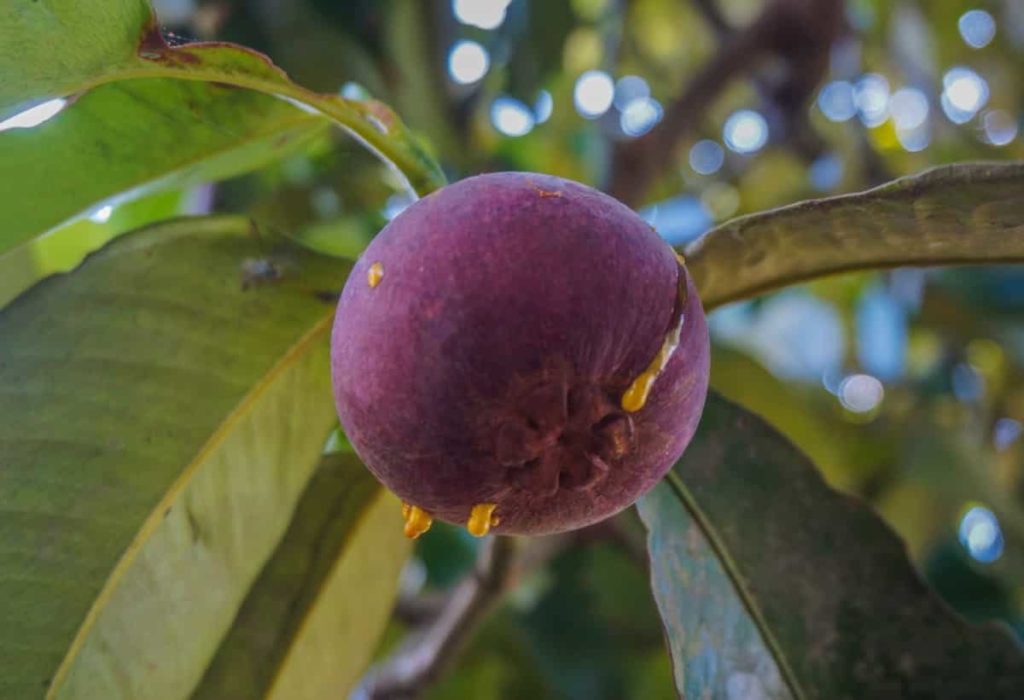
Sand or limestone soil is not suitable for Mangosteen cultivation. Gardeners can solve this problem by including organic materials like peat moss and providing essential nutrients by frequent use of fertilizers. Using an organic source instead of chemical fertilizer is recommended as the tree can easily get injured with excess salt. The tree does not work well in limestone and works best in deep, rich organic soil. Mangosteen tree requires good drainage, and the water level should be about 6 feet below the ground level.
Like any fruit tree, Mangosteen has also required nutrients. These can be supplied through organic (fertilizer) and non-organic (urea, complete fertilizer) material. Mangosteen is a tropical plant. Therefore, it has a lot of requirements for soil quality and climate conditions. Soil fertility needs are vital, and the surrounding water sources are sufficient. Since Mangosteen uses a lot of water and resists high temperatures, the appropriate water is to ensure timely irrigation and meet the water demand of plants.
In short, Mangosteen is a kind of plant that has a long growth cycle. When planting Mangosteen, you need to learn how to grow and make all-around preparations to get a high yield. Potassium plays a crucial role in fruit size and requires large nitrogen during fruit development and growth. However, too much nitrogen at the late growth stage can limit the size of fruits; therefore, applying a balanced nutrient is very important. Phosphorus can also limit fruit growth.
In case you missed it: How to Grow Mangosteens from Seeds: At Home, In Pots, and Backyard
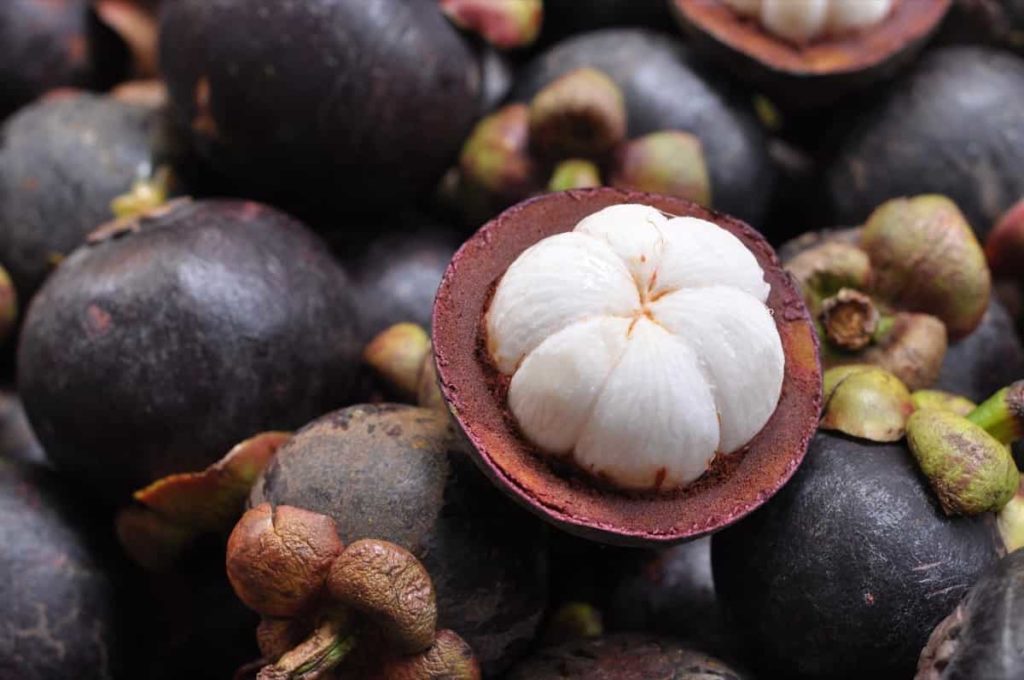
Best fertilizer for Mangosteen tree
Organic fertilizers for Mangosteen
With organic fertilizers like fish emulsion, you can fertilize Mangosteen every three to four months. Continue this procedure until your tree is three years old, and then only fertilize once or twice every year. At the end of winter and early fall, apply fish emulsion. Nutrients must be kept consistent for Mangosteen. You cannot separate the growth of Mangosteen from nutrients. Therefore, when planting young seedlings, it is essential to apply a lot of base fertilizer in association with the preparation of the site.
Base fertilizer can be selected from fermented farmyard manure and compound fertilizer, which can be stirred evenly and spread to the bottom of the hole. Dig a hole at the planting time and fill it with the soil above, chicken manure, and compost. Then let them place for four weeks, and then plant your young tree. Mangosteen responds well to manure and the application of nitrogenic fertilizer. It can accelerate the vegetative growth of your Mangosteen plant.
You should add manure to the soil to keep the plant healthy. You can substitute the application of non-organic fertilizer with vermicast or vermin worm manure without affecting the productivity of Mangosteen. Vermicompost is applied to 5 kg per tree every three months. Then he increases the rate to 10 kg to 20 kg after the fruiting stage. Mulching with compost or straw is beneficial.
In case you missed it: Best Fertilizer for Indian Hawthorn Plants: Organic, Compost, NPK, How and When to Apply
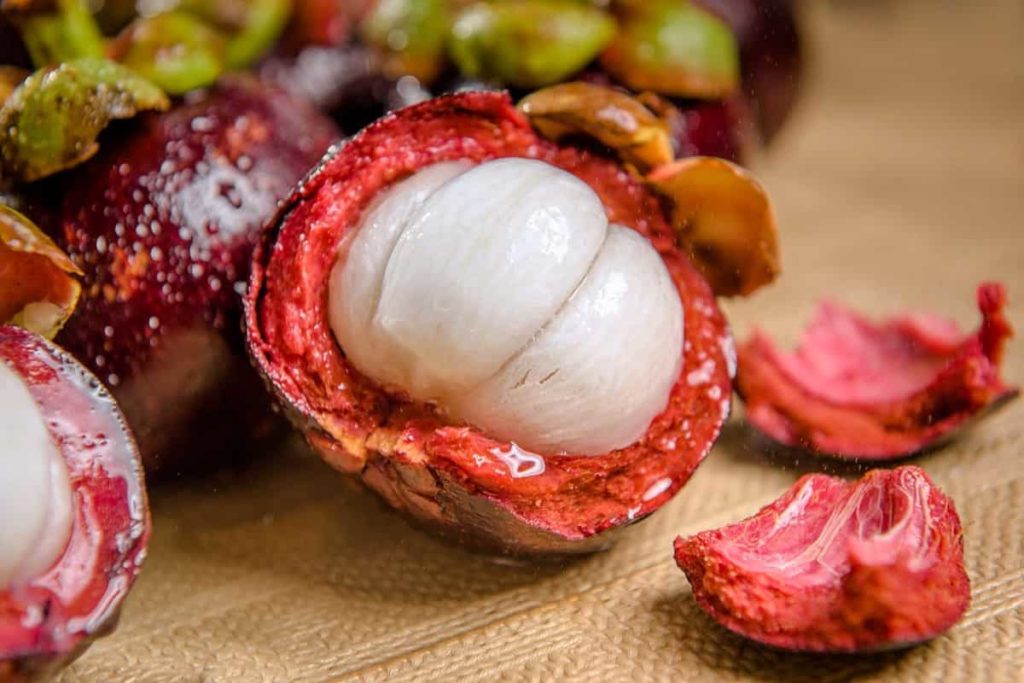
Commercial fertilizers for Mangosteen
NPK ratio
Feed the Mangosteen plant with a nitrogen, phosphorus, and potassium solution, which consists of compounds at 16-16-16 ratios. In addition, you can also use the 20-20-20 (NPK) ratio. Fertilize them every 4 to 5 months. The important thing is to keep the fertilization routine going correctly until the tree turns 3 or 4 years old. You can then add fertilizer once or twice every year. Mangosteen is prone to fruit drops and uneven color during fruit. Therefore, titanium fertilizers are sprayed to promote fruit coloring to improve the quality and production of Mangosteen.
Increase the amount of sugar in fruits, promote early ripening of fruits, improve fruit levels, and improve the smoothness of the fruit and hardness of the peel. Fruit is not easy to crack; it increases photosynthesis, increases the amount of chlorophyll, improves crop resistance, disease prevention, and sunburn. Experts recommend applying 50 to 100 grams of ammonium sulfate a month after planting, again at the end of the rainy season, and after six months.
Mangosteen fertilizer schedule
Mangosteen trees respond well to manuring. Therefore, diluted organic fertilizer absorbed slowly is required. In addition, the use of nitrogenous fertilizer can accelerate plant vegetative growth. The application of fertilizer varies with the age of the plant. Since ammonium sulfate is applied at the time of plantation, the applicant should follow around sketch following the tree canopy. Dig 4 to 6 holes after a circular plan on the ground. Put the manure in holes, cover it to prevent volatilization, and reduce the run-off in case of heavy rain.
At the time of planting, apply 200 to 250 grams of complete fertilizer per tree three inches below the roots and five inches on the edge of the seedling. Fertilizer management in the first year after transplant: In the first year, young trees are still in dry weather when they survive, so urea and fertilizer should be applied once, which can be done with water dosing. For each plant, a dose of 100ml and a concentration of 2% can boost the growth of Mangosteen seedlings.
When we take care of Mangosteen at the beginning of the rainy season, apply organic manure and calcium magnesium phosphate fertilizer. For young trees, mix and broadcast or apply 300 to 500 grams 14-14-14 or 16-16-16 in two equivalent doses, digging a shallow furrow around each tree, 200 to 300 grams urea (45-0-0). Apply the first dose at the beginning of the rainy season and the second dose at the end of the rainy season.
During the fruiting phase, mix again in two equal doses of 1.5 to 3.0 kg 14-14-14 or 16-16-16 plus 200 to 300 grams potash (0-0-60). Gradually, fertilizer increases as the trees grow and fruit production increases. Fertilizer rules and types in the second year are similar to the first year. The difference is that the quantity of fertilizer has changed. When we take care of Mangosteen in dry weather, urea was dissolved in 2% water and fertilizer, and twice you apply 100 ml per tree.
In case you missed it: Best Fertilizer for Kumquat Tree: Homemade, Organic, Compost, Liquid, How and When to Apply
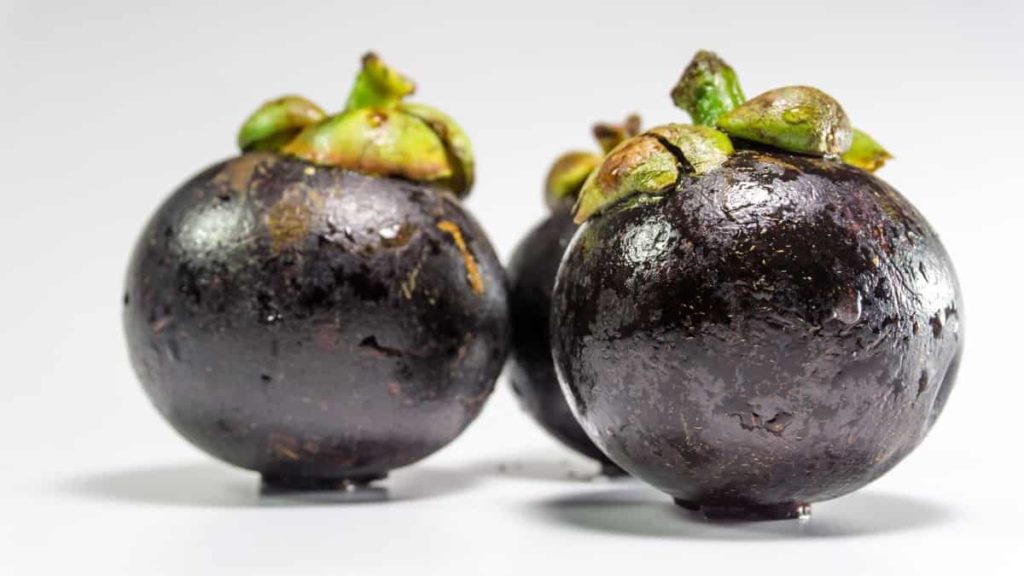
When we grow and take care of dry weather in the third year, when immediate availability of nitrogen fertilizer was dissolved in liquid fertilizer, nitrogen fertilizer intake was increased to plant 2% urea twice on each tree, each time 150ml, a total of 300ml.
How to fertilize Mangosteen in pots
You can plant the Mangosteen plant in an indoor container as long as you provide them with favorable conditions. Generally, it needs ample space to grow well. Moreover, when you grow them indoors, you should worry about the need for plant lighting. Therefore, it would be best to take a pot suitable for planting Mangosteen plants. The diameter of this pot should be 18 to 24 inches, and the height should be more than 20 inches because the Mangosteen root system needs enough space to grow in the pot.
In addition, the pot should have proper drain holes. These drain holes facilitate better drainage of water. Apart from the size of the pot, you should be highly concerned about the type of soil because well-drained soil is an essential thing for Mangosteen plants. Therefore, it is recommended to fill the internal pot to plant Mangosteen with a mixture of sand, soil, and perlite. Use only organic, well-draining soil and determine the requirements in the garden center or nursery where you buy soil.
Mangosteen will not flourish in other soils. You can increase the Mangosteen plant’s growth by providing them with the desired proper nutrition. For example, if you want to eat organic fruit, you can give the plant rotten cow dung manure instead of using fertilizer on a chemical basis from the market.
In case you missed it: Best Fertilizer for Blueberries: Homemade, Organic, Compost, Natural, Liquid, How and When to Apply
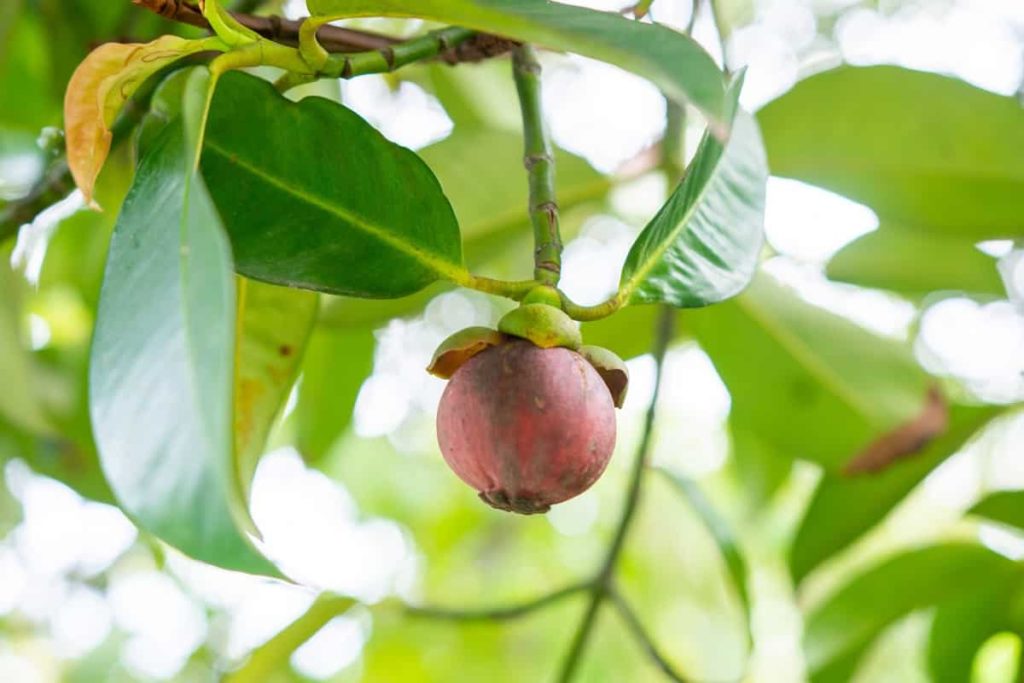
Frequently asked questions about fertilizers for Mangosteen (FAQ)
How much time does it take for Mangosteen to bear fruit?
Mangosteen species mature completely within 30 to 45 years. But trees can reach fruit-bearing after six years. Moreover, Mangosteen is usually propagated by its seeds because Mangosteen plant vegetative propagation is complex.
How tall is the Mangosteen tree grows?
Mangosteen is a slow-growing plant. Typically, it can reach a height of about 9 to 10 meters in the wild. Moreover, favorable conditions encourage plant growth. Mangosteen is a tropical plant. Similar conditions are needed to develop well in a foreign location.
What is the yellow thing in Mangosteen?
Yellow sap contamination indicates poor quality of Mangosteen fruits. Yellow sap is a problem when sap contaminates the surface of fruit or aryl.
In case you missed it: Best Fertilizer for Raspberry Plants: Homemade, Natural, Organic, Compost, and Schedule
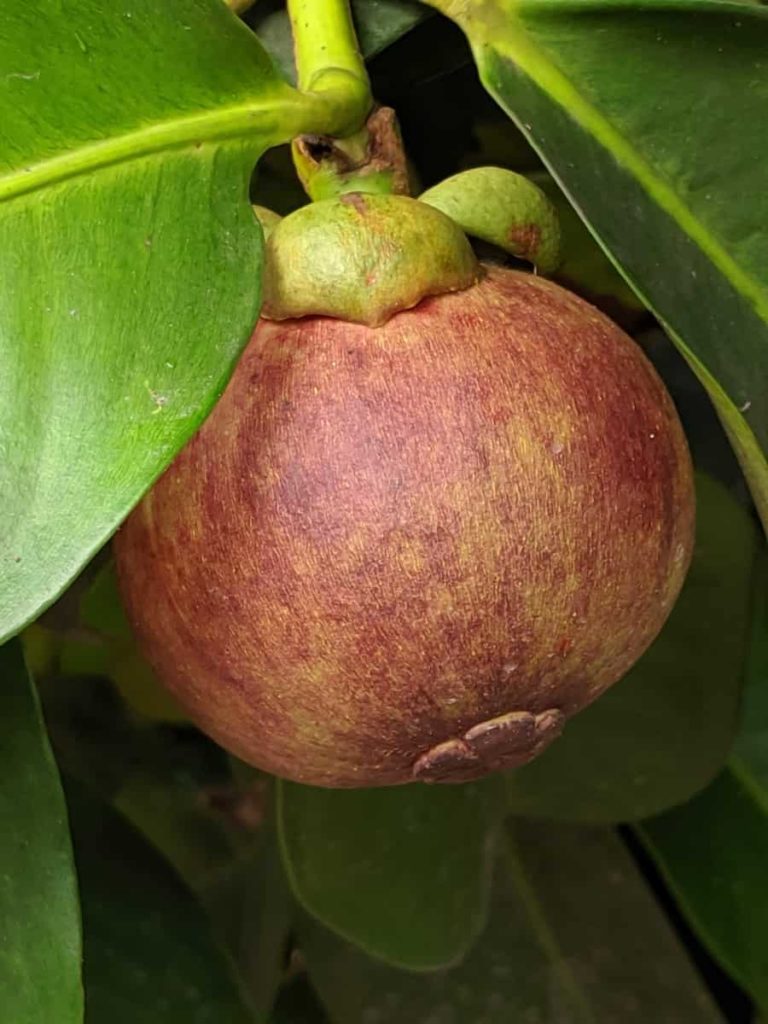
Does Mangosteen need shade?
Mangosteen can do well under the shade as well. However, unlike the fully grown trees, young plants cannot survive directly in sunlight. So, place your plants under the shade or in a place where they get indirect or filtered sunlight.
What kind of fruit is Mangosteen?
Mangosteen is a round-shaped fruit with white flesh. Furthermore, this internal flesh is covered with a thick outer surface. Moreover, the size of these fruits is equal to that of an orange size. It means that the size of the Mangosteen fruits ranges from 1 to 3 inches in diameter.
- How to Grow Hibiscus from Flower
- Plantation Ideas for Home Decoration: A Beginners Guide
- Flower Garden Designs and Layouts for Beginners
- Planting and Spacing Techniques in Papaya: A Beginner’s Guide
- Growing Gold: Essential Techniques for Planting Pineapples
- How to Make Kalanchoe Plant Bushy: Home Remedies and Solutions
- 11 Reasons Why Your Gardenia is Not Blooming: Home Remedies and Solutions
- Eco Elegance: The Guide to Designing a Drought-Tolerant Landscape
- Gardening on a Slope: Strategies for Hillside Landscaping
- Nourish and Flourish: Top Organic Mulches for Thriving House Plants
- Everything You Want to Know about Indian Mogra Flower: Discover Uses and Growing
- Green Thumb Success: Expert Tips for Cultivating Greenhouse Pumpkins All Year Round
- Maximize Growth & Flavor: The Ultimate Guide to Companion Planting in Herb Gardens
- How to Control Rhododendron Problems Naturally: Home Remedies and Organic Ways to Fix Them
- Natural Magic: The Remarkable Benefits of Cinnamon for Plants
- Best Steps to Revive Dying Tulip with Natural and Organic Treatment
- 10 Reasons Why Your Angel Trumpet is Not Blooming: Remedies and Treatment
- How to Fix Periwinkle Leaf and Flower-Related Problems: Natural Remedies and Solutions
- How to Fix Zinnias Leaf and Flower Problems: Discover Natural and Home Remedies
- Organic Steps to Induce Lemon Tree Flowers: A Comprehensive Guide
- Bloom Booster: Crafting the Perfect Homemade Bougainvillea Fertilizer
- Optimizing Growth: A Guide to Applying NPK Fertilizer for Potted Plants
- 10 Best Homemade Fertilizers for Rubber Plant: DIY Recipes and Application Method
- How to Boost Female Pumpkin Flowers: Effective Steps for More Flowers and High Yields
- Transform Your Indoor Garden: Top Benefits of Pink Salt for Houseplants
- 10 Best Homemade Fertilizers for Peacock Plants (Calathea): Easy DIY Guide
- Unlock Blooms: 9 Reasons Why Your Potted Chrysanthemum is Not Blooming
- 8 Reasons Why Your Potted Hibiscus is Not Blooming: Fix it with Simple Solutions
- Unlock Blooms: 9 Key Reasons Your Potted Frangipani Won’t Flower
- 10 Reasons Why Is My Ice Plant Not Blooming: Remedies and Treatment
- 10 Reasons Why My Potted Hydrangea Not Blooming: Treatment and Remedies
- 10 Reasons Why is My Wisteria Not Blooming: Remedies and Treatment
- 10 Reasons Why is My Goldfish Plant Not Blooming: Remedies and Treatment
- Maximize Your Space: Ultimate Guide to Balcony Gardening with Grow Bags
- 10 Reasons Why Your Iris is Not Blooming: Remedies and Treatment
- 10 Reasons Why Your Anthurium Plant is Not Blooming: Treatment and Remedies